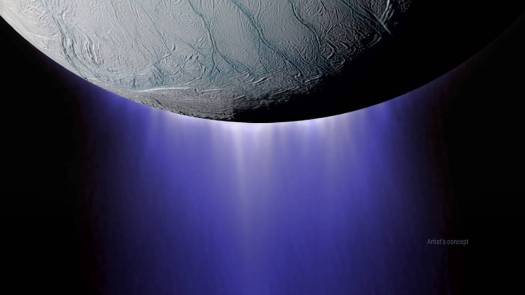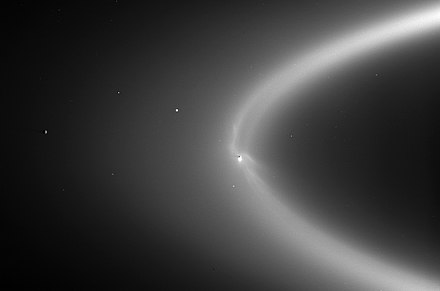
The elements needed for life as we know it are carbon, hydrogen, oxygen, nitrogen sulfur and phosphorus.
Before today, planetary scientists could say that five of those crucial elements had been found in the watery spray that spurts out of the Saturn’s moon, Enceladus. All that was missing was phosphorus.
But today research presented in the journal Nature reports that signatures of phosphorus had indeed been captured when NASA’s Cassini spacecraft flew around Enceladus between 2005 and 2017. The element, however, had not been detected by scientists examining data from the plume.
Now it has been detected, and in significant amounts.
As described in the article’s abstract: “Our observational results, together with laboratory analogue experiments, suggest that phosphorus is readily available in Enceladus’s ocean in the form of orthophosphates, with phosphorus concentrations at least 100-fold higher in the moon’s plume-forming ocean waters than in Earth’s oceans.”
That means Enceladus is the only object beyond Earth known to have an ocean containing all six elements needed for life.


The Cassini spacecraft flew 23 flybys at Enceladus between 2005 and 2017, when the spacecraft was sent it plunging into the atmosphere of Saturn.
It was determine earlier that all the CHNOPS elements but phosphorus (as those life-necessary elements are sometimes called) were present. That was a big missing piece because phosphorus is present both in DNA and RNA, as it forms the backbone of the nucleic acid.
Finding phosphorus required years of analysis of data from particles impacting an instrument on Cassini as it hurled past the icy moon.
“We now really have found that Enceladus’s subsurface ocean is the most habitable place in the solar system, at least as far as we know,” said lead author Frank Postberg, a professor at the Free University of Berlin.

He made sure to add, however, “that doesn’t mean that it’s actually hosting life, that it’s inhabited.”
A small moon only few hundred miles in diameter, Enceladus seems to have what scientists call a “soda ocean” — carbonated, bubbly, salty. Postberg said it might taste a little soapy if you could drink it.
The global ocean lies beneath a layer of ice many miles thick, but frozen particles seep through cracks in the ice and spurt into space.
Like the moons Europa, Titan, and Callisto, Enceladus can hold liquid water below its ice because of the heat generated by gravitational forces connecting the moons and their giant planets, Saturn and Jupiter. Some think that heat from radioactive elements might also play a role.


Many astrobiologists and planetary scientists have strongly advocated for a mission specifically designed to explore possible life on Enceladus. While Cassini did visit the moon many times, it did not have the instruments necessary to make the kind of analysis that could determine if biology is present.
There have been numerous plans put forward by NASA, by the German Space Agency, the European Space Agency and by the non-profit Breakthrough Enceladus proposed by tech billionaire Yuri Milner.
Many potential missions remain under study including the Enceladus Orbilander, which was strongly recommended last year as a future mission for the 2050s. It was proposed in the 2023-2032 Planetary Science Decadal Survey as the third highest priority Flagship mission, after the Uranus Orbiter and Probe and the Mars Sample Return program.
Perhaps the firm identification of phosphorus in the ocean of Enceladus will make the case for an astrobiology mission to the moon strong enough to speed up planning.

One Reply to “”
Comments are closed.